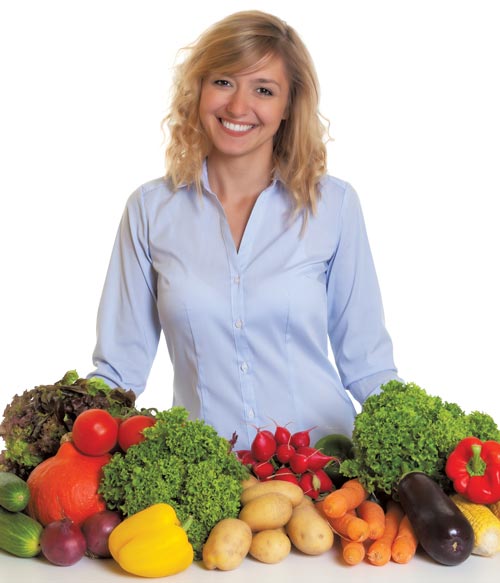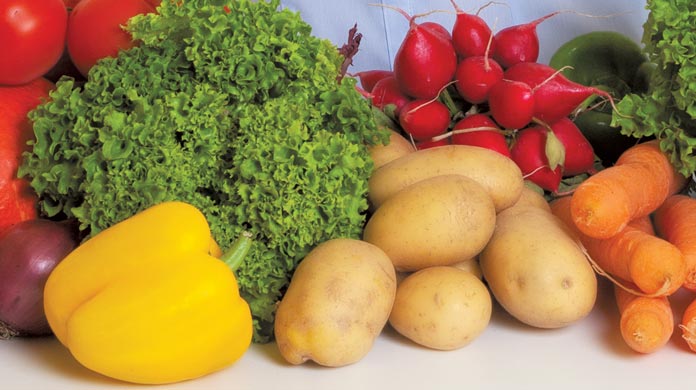Article contributed by Joy Pouros, Culinary Software Services
 The concept of organic has been around since the early 20th century, but the organic market has exploded in growth since the 1990s. In the early 2000s, it was growing at an astounding 17-20 percent annually; now it has steadied a bit to a still-impressive 10-11 percent growth rate. To compare, the conventional food market has grown by 2-4 percent each year.
The concept of organic has been around since the early 20th century, but the organic market has exploded in growth since the 1990s. In the early 2000s, it was growing at an astounding 17-20 percent annually; now it has steadied a bit to a still-impressive 10-11 percent growth rate. To compare, the conventional food market has grown by 2-4 percent each year.
While the most commonly thought of organic products include fruits and vegetables, the USDA defines organic production as “cultural, biological, and mechanical practices that foster cycling of resources, promote ecological balance, and conserve biodiversity.” That broad definition means there’s a lot more to organic than produce! The organic market has expanded substantially to include grains, meat, dairy, and even processed foods, in addition to produce. It has also spilled over to the foodservice industry where it is common to see “organic” on a menu. And, it’s not just limited to food items; nonfood products including alcohol, textiles and personal care products can also be organic. It’s clear there’s great opportunity to be had in taking advantage of the demand for organic products.
Let’s dive deeper into those trends and look at the driving forces behind this growth.
Food and Health
In decades past, consumers were thrilled with technological advances that allowed foods to last longer, travel further, or taste better and were satisfied so long as foods passed regular FDA regulations. In recent years that has not been the case. People have become increasingly concerned about the chemicals, hormones, and antibiotics used to grow or raise and process our food. That concern is no longer taboo or relegated to a fringe community.
Those concerns are further reaching than ingredients alone. Where products labeled as natural can satisfy some consumers, the FDA and USDA do not monitor those claims as they do “organic.” Organic product claims are heavily regulated, with specific rules about what chemicals organic products can and cannot contain. This gives organic an edge over natural products for consumers who are concerned about not just ingredients, but exposure to “unnatural” chemicals or additives.
You may notice that nothing about the USDA’s description indicates additional nutrients. To be clear, the research does not indicate that organic produce has more nutritious value than the non-organic counterparts. It’s less about how much vitamins and minerals you are getting and more about what you are not getting. Many consumers with autoimmune diseases or allergies prefer eating organically to avoid the hormones and specific chemicals that aggravate their health condition and this is one reason behind the push to “label” items on restaurant menus as organic.
That said, organic products benefit from healthier food trends, even if those trends are not organic-specific. Take produce. Believe it or not, vegetables are cool right now. Who hasn’t seen Brussels sprouts making a comeback on a restaurant menu? There’s also been an increase in vegetables as a substitute for other ingredients, including vegetables as pasta – think squash noodles – or vegetables as pizza crusts and other unorthodox uses. Dried vegetables and fruits are even replacing bags of chips (e.g. kale chips), a thought that would have made many laugh in disbelief just a few years ago. However, since companies producing organic items focus on healthy foods, those organic items see a boost in sales, even from customers who are not committed to buying organic continuously.
Animal Welfare and Environmental Sustainability
It’s not just their own health that consumers are thinking about. People who are unhappy with the treatment of animals but are not ready to turn to veganism eat organic meat and dairy as an alternative. Regulations regarding organic status extends to how animals are raised. They cannot be given synthetic hormones or antibiotics, and must be fed organic feed. After all, if you don’t want to eat GMOs, do you want your food to eat GMOs either? Animals must also be provided with safe, clean, living conditions with access to the outdoors.
Consumers concerned about the environment also find organic products to be beneficial to their cause. Organic products utilize a sustainable means of production, which is increasingly important to consumers. Organic farming recreates the need for sustainable farm practices like crop rotation, which in turn promotes healthy soil at less risk for erosion. Pesticides and other chemicals affect air quality, remain in the soil for long periods of time, and can run off into water sources. While pesticides are intended to protect crops, they inadvertently also provide disease resistance to plant-eating insects, bacteria, and fungi. This creates a cycle where increased or new pesticides will consistently be needed to address those crop-killers. Organic farming has also been shown to slow climate change.
Education and Connectivity
While we can see many reasons that consumers care about organic products, those points alone are not enough to spur the kind of growth the industry has experienced. Access to this information is a critical component to the trend.
The general population is becoming more aware of what goes into their bodies, and the information about what’s going into their bodies is more readily available via documentaries and the ease of research on the internet. “Super Size Me” made waves in the early 2000s, but many lesser known documentaries and educational films or series have become widely available. These films cover animal welfare, the food industry’s impact on the environment, and ingredients and chemicals in food products. They may not be on the big screen at a local theater near you, but they are making an impact on those who watch them.

People don’t even need to seek out information anymore. Their social media channels curate the information and give it to them directly. As eating “clean” has become more popular, so have recipes on Pinterest that detail how to make organic meals and snacks that taste better than their processed equivalent, infographics that tout the “dirty dozen” foods to always buy organic, tips for eating organically on a budget, and more. Before social media, a person may not have known if they had any acquaintances who ate organically, but Facebook and other social media channels enable friends, even ones you don’t know very well, to share their organic lifestyle publicly. This kind of social influence can strongly impact individuals and make them likelier to try something new.
Of course, much of the information coming from social acquaintance may just be surface information, but the internet has enabled consumers to research virtually any topic they want to learn more about. Blogs and websites on organic products are plentiful. Plus, shoppers don’t need to rely on their memory when grocery shopping. They have access to research anywhere they go, and the ability to look up ingredients.
Acceleration Via Accessibility
The food industry itself made this happen. As organic products began gaining some traction in the past 15-20 years, traditional grocers began giving them some shelf space in their stores. Whole Foods Markets, a beacon for organic and healthy foods, has practically upended traditional grocers seeking the same amount of sales growth. As the public had more access to organic products outside of niche natural stores, they purchased more product, contributing to the trend, and stores allocated even more space for organic products. As the organic market grew, products became more innovative; there were less raw products and more convenience foods like fruit snacks, boxed mac ‘n cheese mix, premade dips, and the ilk.
It’s no secret consumers value convenience. Easier access to the products and the products becoming more consumer friendly themselves have also contributed to the continued growth of organic products, even among consumers who do not have a strong conviction to a specific cause. In fact, over 82% of households buy some organic product, and organic foods account for more than 5% of retail food sales. It’s enough to grab the attention of large mainstay companies, who are also adapting to this trend by including organic products, albeit slowly. General Mills and Coca-Cola, among others, have both purchased organic businesses. Chipotle and Wendy’s are examples of large-scale food chains who have incorporated organic ingredients or products on a large scale.
Organic products address environmental, animal welfare, and health concerns by encompassing hormones and antibiotics given to animals, GMOs and synthetic fertilizers used in crops, and sustainability practices for the environment. All of these issues have seen an increase in popularity recently, and the organic market benefits in each of these cases. What’s more, the market doesn’t show signs of slowing. Consumers of organic products are skewing young, and there’s an uptick when women become pregnant or a family has young children. Those demographics get larger each year, as is the opportunity for more companies to get on board and have a piece of the organic pie.
Joy Pouros works as the authority writer in the Training department at Culinary Software Services, where she writes on topics as diverse as human resource issues to increasing profits. Joy entered the industry working as a Nutritional Aide in the Chicagoland area before moving into writing and consulting. She now specializes in marketing and public relations and writes for a variety of industries.
























Comments are closed.